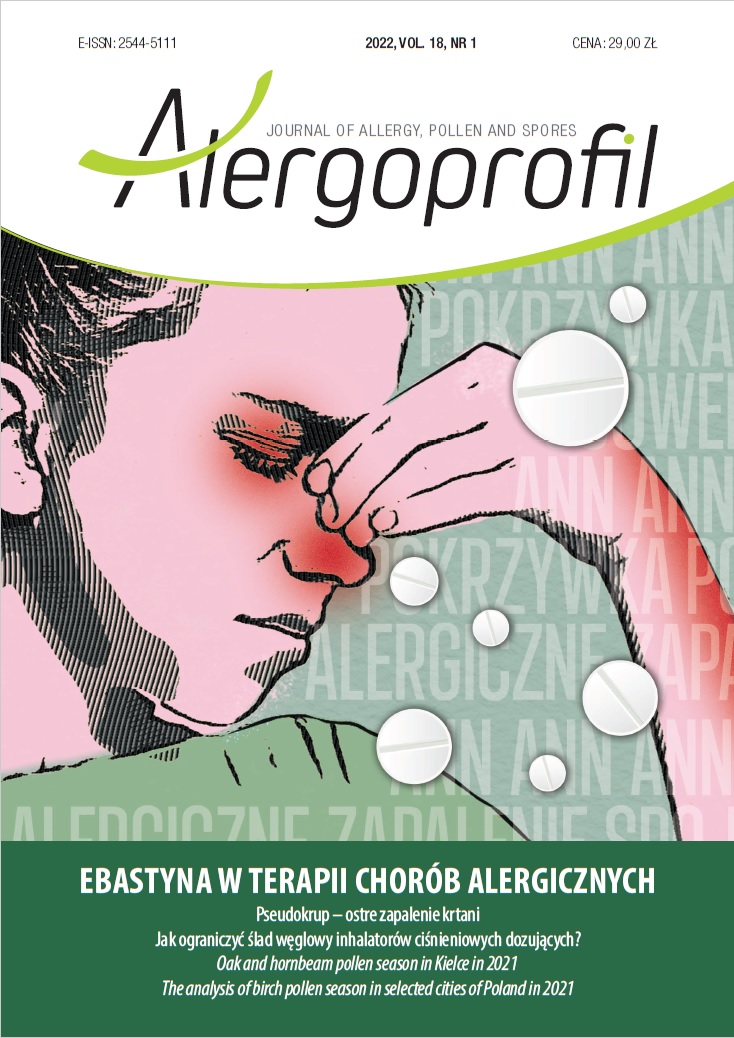Sezon pylenia dębu i grabu w Kielcach w 2021 roku Artykuł oryginalny
##plugins.themes.bootstrap3.article.main##
Abstrakt
W pracy przedstawiono charakterystykę sezonów pylenia dębu i grabu w Kielcach w roku 2021. Pomiar aeropalinologiczny przeprowadzony zostały metodą wolumetryczną. Główny sezon pyłkowy dębu trwał 35 dni. Maksymalne stężenie pyłku dębu zaobserwowano 20 maja w ilości 227 ziaren w 1m3 powietrza, a sezonowy indeks pyłkowy wyniósł 1533. Okres pylenia grabu był dłuższy i obejmował 56 dni. Szczytowe pylenie grabu zaobserwowano 28 kwietnia w ilości 22 ziaren pyłku w 1m3 powietrza, przy rocznej sumie stężeń równej 207. W badaniach określony został także wpływ wybranych czynników meteorologicznych na zawartość ziaren pyłku badanych taksonów roślin. Analizowane parametry meteorologiczne najsilniej oddziaływały na dynamikę pylenia grabu.
Pobrania
##plugins.themes.bootstrap3.article.details##

Utwór dostępny jest na licencji Creative Commons Uznanie autorstwa – Użycie niekomercyjne 4.0 Międzynarodowe.
Copyright: © Medical Education sp. z o.o. This is an Open Access article distributed under the terms of the Attribution-NonCommercial 4.0 International (CC BY-NC 4.0). License (https://creativecommons.org/licenses/by-nc/4.0/), allowing third parties to copy and redistribute the material in any medium or format and to remix, transform, and build upon the material, provided the original work is properly cited and states its license.
Address reprint requests to: Medical Education, Marcin Kuźma (marcin.kuzma@mededu.pl)
Bibliografia
2. Rapiejko A, Malkiewicz M, Ziemianin M et al. Oak pollen concentratio n in the air of selected Polish cities in 2020. Alergoprofil. 2020; 16(4): 15-20. http://doi.org/10.24292/01.AP.1643311220.3.
3. Rapiejko P. Alergeny pyłku dębu. Alergoprofil. 2007; 3(3): 34-8.
4. Lipiec A, Puc M, Malkiewicz M et al. Analiza stężenia pyłku dębu w wybranych miastach Polski w 2015 r. Alergoprofil. 2015; 11(3): 45-9.
5. Dąbrowska-Zapart K, Chłopek K, Malkiewicz M et al. Oak pollen season in selected cities of Poland in 2019. Alergoprofil. 2019; 15(2): 12-6. http://doi.org/10.24292/01.AP.152150919 .
6. Szafer W, Kulczyński S, Pawłowski B. Rośliny Polskie. PWN, Warszawa 1988.
7. Puc M, Myszkowska D, Chłopek K et al. Oak pollen in the air of Poland in 2017. Alergoprofil. 2017; 13(3): 124-8. http://doi.org/10.24292/01.ap.300917.
8. Rapiejko P, Lipiec A, Jurkiewicz D. Alergogenne znaczenie pyłku dębu. Alergia. 2004; 2: 38-41.
9. Rapiejko P, Stankiewicz W, Szczygielski K et al. Progowe stężenie pyłku roślin niezbędne do wywołania objawów alergicznych. Otolar Pol. 2007; 61(4): 591-4.
10. Burge HA. Monitoring for airborne allergens. Ann. Allergy. 1992; 9: 9-21.
11. Puc M, Kotrych D, Piotrowska-Weryszko K et al. Hornbeam pollen in the air of Poland in 2018. Alergoprofil. 2018; 14(3): 72-6. http://doi.org/10.24292/01.AP.291918.
12. Chłopek K, Rapiejko P, Lipiec A et al. Analiza stężenia pyłku grabu (Carpinus) w wybranych miastach Polski w 2007 r. Alergoprofil. 2007; 3(3): 39-44.
13. Pidek IA. Carpinus betulus pollen accumulation rates in Roztocze (SE Poland) in relation to presence of Carpinus in Ferdynandovian pollen diagrams. Ecological Questions. 2017; 27: 95-101. http://doi.org/10.12775/EQ.2017.023.
14. Bachofer M, Mayer J. Drzewa. MULTICO Oficyna Wydawnicza, Warszawa 2007.
15. Pokorny J. Drzewa znane i mniej znane. Polska Oficyna Wydawnicza „BGW”, Warszawa 1992.
16. Seneta W, Dolatowski J. Dendrologia. PWN, Warszawa 2008.
17. Mattiesen F, Ipsen H, Lowenstein H. Pollen allergens. In: D’Amato G, Spieksma FTM, Bonini S (ed). Allergenic pollen and pollinosis In Europe. Blackwell Scientific Public, London 1991: 36-44. mined by cross-hybridization. J. Allergy Clin. Immunol. 1991, 87(3): 677-82.
18. Valenta R, Breiteneder H, Petternburger K et al. Homology of the major birch-pollen allergen, Bet v I, with the major pollen allergens of alder, hazel and hornbeam at the nucleic acid level as determined by cross-hybridization. J Allergy Clin Immunol. 1991; 87(3): 677-82.
19. Rapiejko P. Wybrane aspekty alergii krzyżowej. Alergoprofil. 2006; 2(2): 11-5.
20. Lipiec A, Puc M, Kalinowska E et al. Pyłek grabu w powietrzu wybranych miast Polski w 2014 r. Alergoprofil. 2014; 10(3): 48-53.
21. Gumowski PI, Clot B, Davet A et al. The importance of hornbeam (Carpinus sp.) pollen hypersensitivity in spring allergies. Aerobiologia. 2000; 16: 83-6.
22. Emberlin J, Savage M, Jones S. Annual variations in grass pollen seasons in London 1961-1990: trends and forecast models. Clin Exp Allergy. 1993; 23(11): 911-8.
23. Instytut Meteorologii i Gospodarki Wodnej – Państwowy Instytut Badawczy. (access: 27.07.2021).
24. Ślusarczyk J, Kopacz-Bednarska A, Posłowska J. Characteristics of ash, maple, yew/juniper, and willow pollen seasons in the air of Kielce in 2021 in correlation with weather conditions. Alergoprofil. 2021; 17(4): 3-10. http://doi.org/10.24292/01.AP.174181021.
25. Ianovici N, Bîrsan MV. The influence of meteorological factors on the dynamic of Ambrosia artemisiifolia pollen in an invaded area. Not Bot Horti Agrobo. 2020; 48(2): 752-69. http://doi.org/10.15835/nbha48211862.
26. Dąbrowska-Zapart K, Chłopek K, Niedźwiedź T. The impact of meteorological conditions on the concentration of alder pollen in Sosnowiec (Poland) in the years 1997–2017. Aerobiologia. 2018; 34: 469-85. http://doi.org/10.1007/s10453-018-9524-8.
27. Majeed HT, Periago C, Alarcón M et al. Airborne pollen parameters and their relationship with meteorological variables in NE Iberian Peninsula. Aerobiologia. 2018; 34: 375-88. http://doi.org/10.1007/s10453-018-9520-z.

